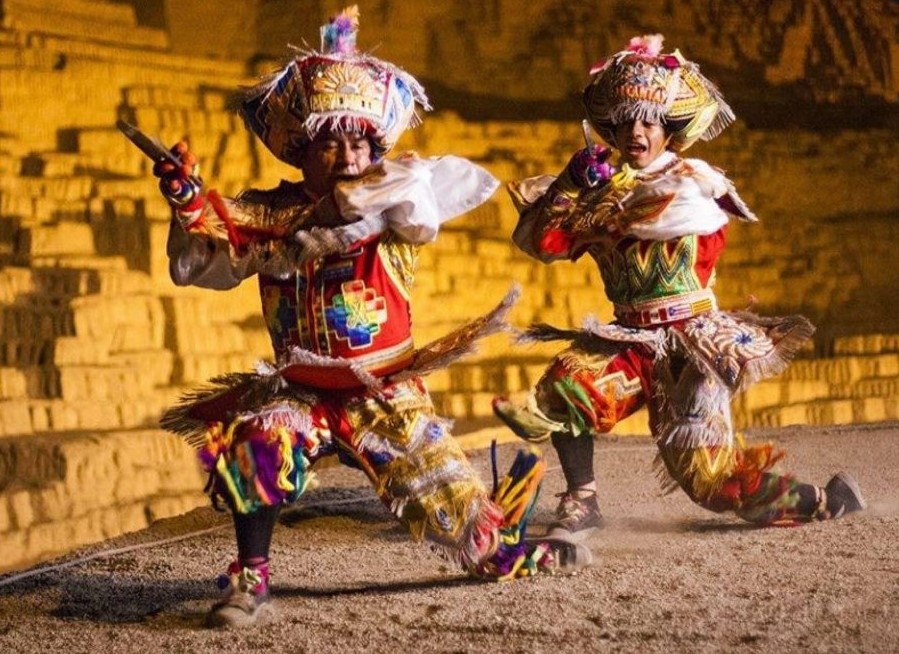Numerous major civilizations, some of which predate the Incas, emerged in Peru and laid the foundation for a unique cultural expression that developed over time. The ancient Peruvians’ way of life was gradually altered when new customs were brought in by the Spanish colonizers.
African, Asian, and European influences additionally shaped the country’s historical and cultural development. These many cultural backgrounds made it possible to combine various aspects of one culture into one that is even more varied thanks to its unique tastes, intriguing rituals, melodic music, and exquisite dances.
These days, religious and civic festivals are an expression of joy for holidays or other special occasions, and they frequently feature traditional dances and music that capture the enthusiasm and mysticism of the local people.
Peruvian National dances are a cultural expression that charts the history of the nation. A few of these dances are included in the Intangible Cultural Heritage of Humanity list after being acknowledged by Unesco. We’ve selected four of the most well-liked ones for you to check out on your upcoming trip!
The Marinera
It is the most well-known tradition in northern Peru, particularly in Trujillo, and is regarded as the most iconic and romantic traditional dance in all of Peru. This 1986 Cultural Heritage depicts a courting dance with tasteful, sophisticated, and seductive movements between a couple.
This dance has numerous variations, with three regions—Trujillo, Lima, and Puno—having distinctly different music lyrics, sounds, and movements—yet they all aim to convey the same idea. In northern Peru, the Marinera is so well-liked that hundreds of people compete annually in the National Marinera Contest to choose the finest Marinera couple.
Thousands of tourists from both domestic and other countries visit Trujillo city at the end of January. In terms of musical style, it has evolved into a distinctively Peruvian genre with nationalistic connotations.
It is mostly made up of a “tarola” and/or “cajón” base (instrument), guitar accompaniment, one “voice” played with saxophone and trumpet, a second voice played with tuba, trombone, and clarinet, and optional violin accompaniment. However, it may vary depending on the various regions of the territory.
Danza de Tijeras (Dance of Scissors)
This is the most mysterious dance in the whole country, with dancers serving as the locals’ go-betweens for Mother Earth and the Andes. The performer of this remarkable dance must train hard to execute the fast and acrobatic movements. It is a highly demanding dance as this performance takes place primarily in rural areas during civic and religious festivals.
The dancers in pre-Hispanic times were descended from shamans, fortune tellers, priests, and witches who had suffered persecution during the colonization process. In Quechua, they were frequently referred to as Supaypa Wawan, or Sons of the Devil.
Because of the “scissors” they employed and the way they moved during the dance, the Catholic priests thought that the mystical aspect of this dance signified a deal with the devil. Two 25-centimeter metal plates were elaborated into these scissors to create a pair of blunt-tipped scissors.
Dancers from various Andean tribes have been trained since they were little children to perfect this choreography since it calls for a high level of physical preparedness. To dance under the protection of a mountain spirit, each dancer is given a name connected to the spirit. The violin and harp provide the musical foundation for the Dance of Scissors, which follows a set order but changes significantly and intensifies as the dance moves get riskier.
El Huayno
Mostly performed in the Andean highlands, this dance is the oldest in Peru, dating back to the pre-Hispanic era. The Huayno is the cultural expression of the native Peruvian people of the Andes; while regional variations exist in its music and choreography, the overall essence remains the same.
Historians speculate that the Huayno may have functioned as a military anthem. This dance and musical style underwent a complete transformation with the introduction of new musical instruments and methods by the Spanish.
It is mostly danced by couples and represents enthusiasm, love, joy, motivation, life and spirituality. The lyrics and sounds of this popular Andean music often manifest joy and playfulness, but also sadness and melancholy.
The instruments used in the performance of the huayno are the quena, “charango” (andean ukelele), mandolin, harp, requinto, bandurria, guitar, and violin. However, as it may vary, some traditional bands add trumpets, saxophones, and accordions to the mix.
El Tondero
This dance has more of a bandit and rebel nature, even though it may be compared to the Marinera. It is highly well-liked in the north of Peru, and, like the Marinera dance, the routine depicts a couple courting and falling in love.
The Tondero emerged from a blend of rural and Yunga cultures, in contrast to the other Creole styles that were influenced by Spanish culture. This dance is thought to have its focal point in the Piura town of Morropón.
The first appearances of this dance were accompanied by harmonic harp sounds and later on guitar sounds and Peruvian cajón were included. Each region in northern Peru has its own version but the classic one includes: A main vocalist, a small choir, two guitar players, two Peruvian cajones players, and, as odd as it sounds, a wooden spoon player.
Without question, Peru boasts one of Latin America’s most unique cultures. Along with attending the multitude of dances and musical performances in this nation, you should be aware of the hundreds of Peruvian cultural events.
Make the most of your journey and learn everything there is to know about the wonders of our nation. Remember that Viagens Machu Picchu is a respectable travel company that has helped over 40.000 travelers fulfill their trip dreams in Peru. We encourage you to check out these Peru trip packages for further inspiration!
Viagens Machu Picchu, journeys that inspire, moments that last.

